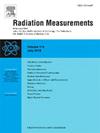PGNAA中硼浓度测量校准曲线的堆积效应和叠加效应研究
IF 2.2
3区 物理与天体物理
Q2 NUCLEAR SCIENCE & TECHNOLOGY
引用次数: 0
摘要
在以往的研究中,采用内标材料对PGNAA法测量硼浓度时的自屏蔽效应进行了修正。校正自屏蔽后,校正曲线仍有一定的曲率,这是与模拟光谱相关的校正曲线所没有的。模拟与实验的基本区别在于,没有对HPGe探测器的实际探测过程及其相关电子器件进行模拟。产生这种差异的原因是实验过程中对光谱的堆积和叠加效应。在本研究中,研究了不同光谱峰处的堆积效应和叠加效应。提出了两种方法来纠正这些影响。在第一种方法中,从内标材料的光谱中选择合适的峰,并对自屏蔽效应进行了修正;在第二种方法中,分别减少了标准样品的质量,增加了光谱测定时间。通过不同的实验对这些方法的结果进行了评价。结果表明,在自屏蔽效应的校正中,氯的788 keV + 786 keV峰表现最好。在不同氯峰绘制的校准曲线中,以788 keV + 786 keV绘制的曲线线性关系最好。曲线的r平方是0.99891。同时,通过减少标准样品的质量来获得校准曲线,可以减小堆积效应和累加效应对校准曲线的非线性影响。通过将用于获得校准曲线的标准样品的体积从10 ml减少到4 ml,第一种方法获得的校准曲线的r平方从0.99891增加到0.99904。本文章由计算机程序翻译,如有差异,请以英文原文为准。
Investigation of the pile-up and summation effects on the calibration curves of boron concentration measurement in PGNAA
In the previous research, the self-shielding effect in boron concentration measurement using PGNAA method was corrected by an internal standard material. After correction of the self-shielding, the calibration curve still has some curvature that was not seen in the calibration curve related to simulations spectra. The basic difference between the simulations and experiments was that the actual detection process in an HPGe detector and its related electronics were not simulated. The reason of this difference is the pile-up and summation effects on the spectra during the experiments. In this study, the pile-up and summation effects have been investigated at the different peaks of the spectra. Two methods have been proposed to correct these effects. In the first method, a suitable peak from the spectrum of the internal standard material has been selected and the self-shielding effect has been corrected and in the second method, the mass of the standard samples and the spectrometry time have been reduced and increased, respectively. The results of these methods have been evaluated by different experiments. Results shows that in the correction of the self-shielding effect, the 788 keV + 786 keV peak of chlorine has the best performance. Among the calibration curves plotted with different chlorine peaks, the curve plotted using 788 keV + 786 keV peak had the best linearity. The R-square of this curve was 0.99891. Also, it was found that reducing the mass of the standard samples used to obtain the calibration curve, reduces the nonlinearity caused by the pile-up and summation effects on the calibration curve. By reducing the volume of standard samples used to obtain the calibration curve from 10 ml to 4 ml, the R-squared of the calibration curve obtained in the first method increased from 0.99891 to 0.99904.
求助全文
通过发布文献求助,成功后即可免费获取论文全文。
去求助
来源期刊

Radiation Measurements
工程技术-核科学技术
CiteScore
4.10
自引率
20.00%
发文量
116
审稿时长
48 days
期刊介绍:
The journal seeks to publish papers that present advances in the following areas: spontaneous and stimulated luminescence (including scintillating materials, thermoluminescence, and optically stimulated luminescence); electron spin resonance of natural and synthetic materials; the physics, design and performance of radiation measurements (including computational modelling such as electronic transport simulations); the novel basic aspects of radiation measurement in medical physics. Studies of energy-transfer phenomena, track physics and microdosimetry are also of interest to the journal.
Applications relevant to the journal, particularly where they present novel detection techniques, novel analytical approaches or novel materials, include: personal dosimetry (including dosimetric quantities, active/electronic and passive monitoring techniques for photon, neutron and charged-particle exposures); environmental dosimetry (including methodological advances and predictive models related to radon, but generally excluding local survey results of radon where the main aim is to establish the radiation risk to populations); cosmic and high-energy radiation measurements (including dosimetry, space radiation effects, and single event upsets); dosimetry-based archaeological and Quaternary dating; dosimetry-based approaches to thermochronometry; accident and retrospective dosimetry (including activation detectors), and dosimetry and measurements related to medical applications.
 求助内容:
求助内容: 应助结果提醒方式:
应助结果提醒方式:


